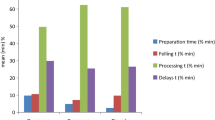Abstract
Objectives
This article compares 2 variants of logging technologies at the motor-manual level: variant A — cutting and delimbing by means of a petrol chainsaw, skidding with the use of a cable winch mounted on a tractor (67–74 kW); variant B — cutting by means of a petrol chainsaw, skidding, debranching and cutting to length by means of a processor aggregated with a farm tractor (61 kW).
Material and Methods
Direct dosimetry and non-parametric (moving block bootstrap) methods were used in order to specify the characteristics of the collected sets.
Results
Bootstrap average values show that the average CO concentration at a skidding tractor operator’s station during early thinning was 2.54 mg×m−3. At processor operator’s station it amounted to 10.35 mg×m−3. Such results allow to conclude that a higher CO concentration at the above-mentioned 2 work stations was observed during early thinning. In the case of a petrol chainsaw operator, it was observed that the permissible exposure limit (23 mg×m−3) was exceeded and the short-term permissible exposure limit (117 mg×m−3) was not. The average concentration value for a chainsaw operator working individually during late thinning interventions was substantially lower (15.01 mg×m−3), which results from the lack of technological pressure that can be observed while cooperating with a processor operator.
Conclusions
The risk increases along with conditions that generate the concentration of exhaust produced by 2-stroke petrol chainsaw engines.
Similar content being viewed by others
References
Ruth-Sahd LA, Zulkosky K, Fetter ME. Carbon monoxide poisoning: Case studies and review. Dimens Crit Care Nurs. 2011;30:303–314, http://dx.doi.org/10.1097/DCC.0b013e31822fb017.
Slaughter JC, Koenig JQ, Reinhardt TE. Association between lung function and exposure to smoke among firefighters at prescribed burns. J Occup Environ Hyg. 2004;1(1): 45–49, http://dx.doi.org/10.1080/15459620490264490.
McMahon CK. Forest fires and smoke — Impacts on air quality and human health in the USA. Proceedings of TAPPI International Environmental Conference; 1999 Apr 18–21; Nashville (TN), USA. Atlanta: TAPPI Press; 1999;1–3, p. 443–453.
Athanassiadis D. Energy consumption and exhaust emissions in mechanized timber harvesting operations in Sweden. Sci Total Environ. 2000;255(1–3):135–143, http://dx.doi.org/10.1016/S0048-9697(00)00463-0.
Lijewski P, Merkisz JFP. Research of exhaust emissions from a harvester diesel engine with the use of portable emission measurement system. Croat J Forest Eng.2013 [cited 2013 Oct 15];34(1):113–123. Available from: http://www.crojfe.com/r/i/lijewski_113-122.pdf.
Magagnotti N, Picchi G, Sciarra G, Spinelli R. Exposure of mobile chipper operators to diesel exhaust. Ann Occup Hyg. 2014;58(2):217–226, http://dx.doi.org/10.1093/annhyg/met059.
Sowa J, Leszczyński K. Emission of carbon monoxide during work with a power chain saw and cable winch propelled by a chain saw engine. In: Sowa J, Barszcz J, Sosnowski A, editors. International Scientific Conference “Ecological, Ergonomic and Economical Optimization of Forest Utilization in Sustainable Forest Management”; 2005 June 15–18; Kraków-Krynica, Poland. Kraków: Publishing House of the University of Agriculture in Krakow; 2005. p. 375–393.
Fisz M. Probability theory and mathematical statistics. 3rd ed. New York, London, Sydney: John Wiley & Sons, Inc; 1967.
Dudek A, Goćwin M, Leśkow J. Simultaneous confidence bands for the integrated hazard function. Comput Stat. 2007;23(1):41–62, http://dx.doi.org/10.1007/s00180-007-0067-7.
Mammen E, Nandi S. Bootstrap and resampling. In: Mori WHY, Gentle JE, editors. Handbook of computational statistics. Berlin-London: Springer; 2004. p. 467–496.
Lahiri SN. Resampling methods for dependent data. 1st ed. Berlin: Springer; 2003 [cited 2013 October 15]. p. 4–5. Available from: http://dx.doi.org/10.1007/978-1-4757-3803-2.
Dudek A, Leśkow J. A bootstrap algorithm for data from a periodic multiplicative intensity function. Commun Stat Theor Meth. 2011;40(8):1468–1489, http://dx.doi.org/10.1080/03610921003615849.
Greene WH. Econometric analysis. 5th ed. New Jersey: Prentice Hall; 2003.
[The regulation on maximum concentrations and intensities of factors harmful to health in the work environment. J Laws 2005 No. 212, item 1769 (October 10, 2005)]. Polish.
Green W. An introduction to indoor air quality: Carbon monoxide (CO). United States Environmental Protection Agency; 2008 [cited 2013 Oct 15]. p. 6. Available from: http://www.epa.gov/iaq/co.html.
Leszczyński K. [The evaluation of selected aspects of timber harvesting technologies. Research methodology]. 1st ed. Kraków: Publishing House of the University of Agriculture in Krakow; 2011. Polish.
Stańczykiewicz A, Leszczyński K. [The report from the research project No. NN309423533: Research on the optimization of eco-technology in thinning coniferous stands by application of tractor processor]. Kraków: University of Agriculture in Krakow. Forthcoming 2011. Polish.
van Netten C, Brubaker RL, Mackenzie CJ, Godolphin WJ. Blood lead and carboxyhemoglobin levels in chainsaw operators. Environ Res. 1987;43:244–250, http://dx.doi.org/10.1016/S0013-9351(87)80075-0.
Bünger J, Bombosch F, Mesecke U, Hallier E. Monitoring and analysis of occupational exposure to chain saw exhausts. Am Ind Hyg Assoc J. 1997;58(10):747–751, http://dx.doi.org/10.1080/15428119791012405.
Author information
Authors and Affiliations
Corresponding author
Additional information
This work was supported by the University of Agriculture in Krakow, Faculty of Forestry under grant DS-3412/KULiD.
About this article
Cite this article
Leszczyński, K. The concentration of carbon monoxide in the breathing areas of workers during logging operations at the motor-manual level. IJOMEH 27, 821–829 (2014). https://doi.org/10.2478/s13382-014-0300-x
Received:
Accepted:
Published:
Issue Date:
DOI: https://doi.org/10.2478/s13382-014-0300-x




